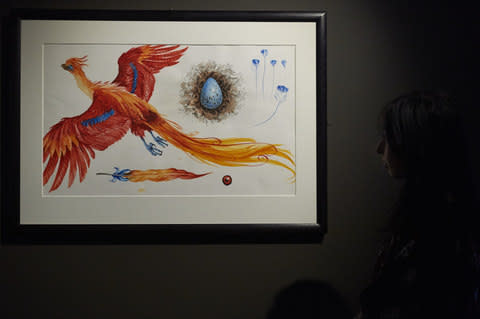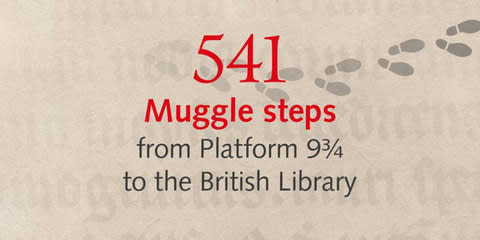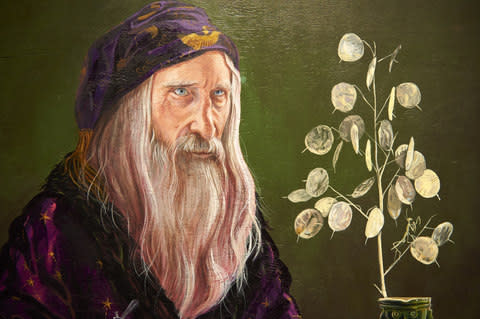First look inside the new Harry Potter exhibition at the British Library

Alchemy. Is it the search for the elixir of life? The transformation of base metals into gold? Or the 21st-century metamorphosis of a struggling single parent and first-time author into a multi-billionaire and creator of the biggest marketing franchise in history?
The new exhibition Harry Potter: A History of Magic opens at the British Library today with a reported 30,000 tickets already sold. It examines both aspects of the wizarding phenomenon by showing some of the world’s strangest books, manuscripts and objects alongside not only Jim Kay’s charming book illustrations but early drafts and black-and-white drawings by J K Rowling herself. She can draw wonderfully too, dammit.
The exhibition is pleasingly divided into the key subjects taught at Hogwarts School of Witchcraft and Wizardry, from Herbology to Defence Against the Dark Arts. Look up to see flying keys, spell books or potion flasks overhead.
A Golden Snitch zips around the walls of the Charms Room. Young visitors will love the swirling depths of the ‘crystal ball’ and augmented reality constellations from the real 16th-century celestial globe.
There’s an 800 BC cauldron retrieved from the River Thames (possible, if fanciful, proof of early potion-making) and an image of witches from 1490, the earliest we have: two of them are lobbing a snake and a toad into a theatrically bubbling cauldron to create hail.

The 15th-century tombstone of Nicholas Flamel, Parisian landlord and possibly-but-probably-not alchemist, finely carved with three saints, a sun and a moon, stands in a corner. Joseph Wright of Derby’s painting The Alchymist uses almost holy light to show the boiling of urine, making, as it turned out, not gold but far more useful phosphorous. As for the showpiece Ripley Scroll, effectively sixteenth-century instructions for the creation of the Philosopher’s Stone, painted on a 19ft-long roll of paper, it’s a stunner.
Will young Harry Potter fans get it? Will they look at incantations picked out in red ink, the book with the first use of ‘Abracadabra!’ (to be written down repeatedly, each time onitting a letter, then worn around the neck), the horrifying mandrake root like a little old man, the oracle bones from ancient China, or the many drawn phoenixes, dragons and hippogryphs, and realise this is it - this is, at least indirectly, the source material?

Perhaps most fascinating are the intricate plotting notes, drawings and charts of the then-unknown Joanna Rowling, who knew ‘who was going to die and when’ before Harry Potter and the Philosopher’s Stone had even been published. Her own first edition, auctioned for charity, explains movingly how she wrote in a chaos of dog and children.
Special delivery! Coming to #BLHarryPotter tomorrow? Here's some handy info you'll need to know before you visit https://t.co/xY25tJ7IUdpic.twitter.com/DFqrwVWpu9
— The British Library (@britishlibrary) October 19, 2017
The exhibition couldn’t be better placed. The British Library is by St Pancras railway station, over which Harry and Ron flew in their Ford Anglia. It’s minutes to the ‘Trolley Wall’ and Harry Potter Shop in next-door King’s Cross, and to the HQ of Google Arts & Culture, creators of the augmented reality for the celestial globe. Real buffs can take the train from nearby Euston to The Making of Harry Potter Studio Tour at Leavesdon.

Altogether it’s a treat, with plenty to intrigue Potter fans and non-Potter fans alike. Tell you what, though: I wish someone would swat that ruddy Snitch.
Exhibition essentials
Harry Potter: A History of Magic runs at the British Library PACCAR Gallery (01937 546546; https://harrypotter.seetickets.com/tour/harry-potter-a-history-of-magic/calendar) from October 20 2017 to February 28 2018.
Tickets £16 adults, £11 seniors, £8 students, £6 children 5 to 17 years, £5 concessions, free for children aged four and under. Advance booking essential.
See website for Potter Quiz Nights, Curriculum Lectures and Library Lates.
Travelling ‘panel exhibitions’ open at 20 public libraries across Britain, including Leeds, Bournemouth, Glasgow and Reading, for the duration of the exhibition.

Pottering around
Mother Shipton, the ‘Yorkshire Prophetess’, appears in the exhibition with a hooked nose and pointy hat. Visit her cave, which claims to be the oldest tourist attraction in England, near Knaresborough (mothershipton.co.uk).
The Museum of Witchcraft and Magic in Boscastle, famously creepy Cornwall (http://museumofwitchcraftandmagic.co.uk) supplied the dark moon crystal ball used by the Devonshire lass ‘Smelly Nelly.’ You couldn’t make it up. Or…?
Excellent Davenport’s Magic Shop (www.davenportsmagic.co.uk), at Charing Cross since 1898, has a sister organisation in North Walsham, Norfolk, recently reopened as the British Magic Museum (http://britishmagicmuseum.uk)
Jim Kay’s Diagon Alley panorama shows Sir Paul Pindar’s House, built 1599-1600 in the City of London. The Weasleys’ joke shop echoes its bow-fronted timber façade, now in the V&A (vam.ac.uk/content/articles/s/sir-paul-pindars-house).


